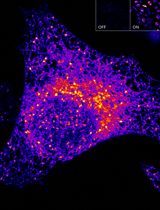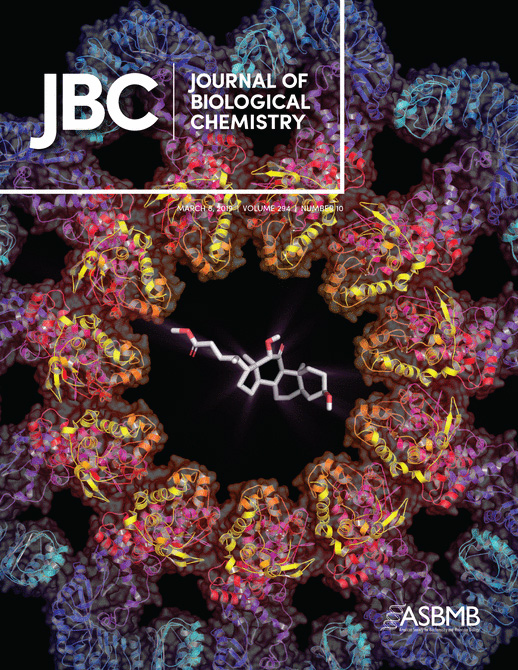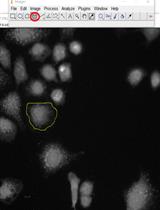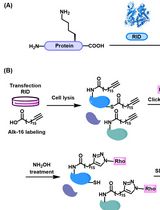- EN - English
- CN - 中文
FRET Reporter Assays for cAMP and Calcium in a 96-well Format Using Genetically Encoded Biosensors Expressed in Living Cells
利用活细胞表达的基因编码生物传感器对96孔甲酸钙和cAMP的FRET检测
发布: 2020年06月05日第10卷第11期 DOI: 10.21769/BioProtoc.3641 浏览次数: 6784
评审: Manuel D GaheteAnonymous reviewer(s)

相关实验方案

高灵敏且可调控的 ATOM 荧光生物传感器:用于检测细胞中蛋白质靶点的亚细胞定位
Harsimranjit Sekhon [...] Stewart N. Loh
2025年03月20日 2167 阅读
Abstract
Stimulation of G protein-coupled receptors (GPCR) by hormones and neurotransmitters elicits cellular responses, many of which result from alterations in the concentrations of cytosolic cAMP and Ca2+. Here, we describe a microplate reader fluorescence resonance energy transfer (FRET) assay that uses the genetically encoded biosensors H188 and YC3.60 so that it is possible to monitor the kinetics with which alterations of [cAMP] or [Ca2+] occur in monolayers or suspensions of living cells exposed to GPCR agonists. This protocol uses HEK293 cell lines doubly transfected with a FRET biosensor and a recombinant GPCR of interest (e.g., glucagon receptors, CCK2 receptors, or NPY2R receptors). The protocol allows for rapid screening of small molecule GPCR agonists and antagonists, and it is also useful for discovery of synthetic mono-, dual-, and tri- agonist peptides with GPCR activating properties.
Keywords: FRET (荧光共振能量转移)Background
Live-cell fluorescence resonance energy transfer (FRET) assays in combination with microscopy and digital imaging technologies are commonly used to monitor the kinetics with which levels of cAMP and Ca2+ fluctuate in response to GPCR agonist stimulation. Here, we report an alternative approach that does not use microscopy but that instead enables FRET-based detection of cAMP and Ca2+ in a 96-well format using an automated microspectrofluorimeter and monolayers or suspensions of living cells. The protocol uses genetically encoded biosensors so that averaged kinetic data for pharmacological studies can be obtained in real time using a microplate reader under conditions in which GPCR agonists are applied at known concentrations. These FRET assays use cell lines stably expressing the cAMP biosensor H188 (Klarenbeek et al., 2015) or the Ca2+ biosensor YC3.60 (Nagai et al., 2004), both of which exhibit superior dynamic range in comparison to earlier FRET reporters. Our protocol describes how H188 or YC3.60 can be expressed stably with recombinant GPCRs so that precise dose-response analysis is achievable. This protocol builds on our published studies, whereby novel dual agonist and triagonist properties of synthetic GPCR agonist peptides (e.g., EP45 and GGP817) were discovered (Chepurny et al., 2018 and 2019).
Using the genetically encoded biosensor Epac1-camps (Nikolaev et al., 2004), we were the first to develop a 96-well microplate FRET assay in which fluctuations of [cAMP] were monitored in monolayers of living cells in real time using a microspectrofluorimeter (FlexStation 3, Molecular Devices) (Chepurny et al., 2009). More recently, we have optimized this approach for purposes of drug discovery in a high-throughput mode. The major technical advance concerns our use of H188 and YC3.60, both of which we find to be highly responsive to cAMP and Ca2+, respectively. Importantly, our plate reader FRET assays using H188 or YC3.60 require their high-level expression, either by stable transfection to generate clonal cell lines (Chepurny et al., 2018), or by adenoviral transduction of cell lines (Chepurny et al., 2018 and 2019). Transient transfection is not useful since low-level expression of these biosensors is not compatible with the limited light detection limits of available microplate readers.
For the H188 reporter expressed in our clonal C24 HEK293 cell line, the cAMP-elevating agent forskolin induces a maximal 100% increase of the 485/535 ∆FRET ratio, a response that greatly exceeds the 12% value typically observed using Epac1-camps (Chepurny et al., 2009 and 2018). This C24 clone exhibits high sensitivity (EC50 500 nM) and excellent Z-score (0.77) when testing forskolin (Chepurny et al., 2018). Calibration of the FRET signal is obtained in assays that use digitonin-permeabilized C24 cells expressing H188 and that are bathed in known concentrations of cAMP (Chepurny et al., 2018). When administering forskolin by its bolus injection into individual wells of a microplate containing monolayers of C24 cells, the time course of adenylyl cyclase activation and resultant cAMP production is monitored with high precision within the first 30 s.
We have also created doubly-transfected HEK293 cells lines that stably express H188 or YC3.60 along with recombinant GPCRs of interest. These GPCRs include glucagon, glucagon-like peptide-1 (GLP-1), glucose-dependent insulinotropic peptide (GIP), peptide YY (PYY), corticotropin releasing hormone (CRH), and cholecystokinin (CCK) receptors. It is also possible to perform such FRET assays using HEK293 cells that stably express H188 or YC3.60, but are instead transiently transfected with a GPCR. Conversely it is possible to use a cell line that stably expresses a recombinant GPCR so that cells may then be virally transduced with H188 or YC3.60.
Our real-time kinetic assay using H188 and living cells differs from single-endpoint HTR-FRET assays that monitor levels of cAMP in cell lysates. For example, the LANCE® cAMP assay (Perkin Elmer) uses a Europium-labeled cAMP tracer (FRET donor) in combination with a fluorophore-tagged anti-cAMP antibody (FRET acceptor), both of which are added to a reaction mixture so that the competition of fluorescent cAMP and non-fluorescent cAMP (i.e., endogenous cAMP) for the anti-cAMP binding site on the antibody can be measured. In contrast, H188 is unimolecular in which the cAMP-binding protein Epac1 is flanked by the FRET donor mTurquoise2∆ and the FRET acceptor cp173 Venus-Venus so that a decrease of FRET occurs upon binding cAMP (Klarenbeek et al., 2015). YC3.60 instead uses a Ca2+-binding domain of calmodulin (CaM), and the CaM-binding peptide M13, in combination with the FRET donor ECFP∆11, and the FRET acceptor cp173Venus so that an increase of FRET occurs upon binding Ca2+ (Nagai et al., 2004). Unlike HTR-FRET assays, H188 and YC3.60 allow live-cell real-time determinations of FRET in the kinetic mode.
Summarized below is a detailed FRET assay protocol that provides additional technical information not previously contained in the methods sections of our prior publications (Chepurny et al., 2009, 2018 and 2019). We also present new information concerning previously unpublished methodology that allows GPCR agonist action to be studied in cells that stably express both a recombinant GPCR and a select FRET biosensor.
Materials and Reagents
- 10 ml Serological Pipet (Krackeler, catalog number: 229010B )
- 5 ml Serological Pipet (Krackeler, catalog number: 229005B )
- 1.5 ml Centrifuge Tube (Axygen, catalog number: MCT-150-C )
- 15 ml Centrifuge Tube (Krackeler, catalog number: 229411 )
- 50 ml Centrifuge Tube (Krackeler, catalog number: 229421 )
- 100 mm x 20 mm Tissue Culture Dish (Krackeler, catalog number: 229621 )
- 96-Well Plate Black, Clear Bottom (Corning, catalog number: 3603 )
- 96-Well Plate, V-Bottom (Greiner Bio-One, catalog number: 651201 )
- FlexStation Pipette Tips (Black, 96) (Molecular Devices, catalog number: 9000-0911 )
- Finntip Flex 300 μl Sterile Pipette Tips (Thermo Scientific, catalog number: 94060513 )
- Channelmate 25 ml Inserts (USA Scientific, catalog number: 1346-2510 )
- Multiwell Plate Washer/dispenser Manifold (Sigma, catalog number: M2781-1EA )
- 0.2 μm PES Membrane Filter for Vacuum Filtration
- HEK293/hNPY2R/H188 c18 cells expressing human NPY2R receptor and H188
- HEK293/hGCGR/H188 c10 cells expressing human glucagon receptor and H188
- HEK293/hCCK2R c29 cells expressing human CCK2R only
- Sodium Chloride (Fisher Scientific, catalog number: BP358-1 )
- Sodium Hydroxide (Fisher Scientific, catalog number: BP359-500 )
- Potassium Chloride (Fisher Scientific, catalog number: BP366-500 )
- Magnesium Chloride Hexahydrate (Fisher Scientific, catalog number: BP214-500 )
- Calcium Chloride Dihydrate (Fisher Scientific, catalog number: BP510-100 )
- D-Glucose (Sigma, catalog number: G5767-500G )
- HEPES 1 M Solution (Sigma, catalog number: H0887 ; store at 4 °C)
- Bovine Serum Albumin (Sigma, catalog number: A7030-100G ; store at 4 °C)
- Rat Tail Collagen (Life Technologies, catalog number: A10483-01 ; store at 4 °C)
- Glacial Acetic Acid (Thermo Scientific, catalog number: A38S-500 )
- Phosphate-Buffered Saline, 1x (Corning, catalog number: 21-040-CV )
- DMSO (Sigma, catalog number: D8418-100ML )
- Fetal Bovine Serum (Sigma, catalog number: 12303C-500ML ; store at -20 °C)
- Dulbecco’s Modified Eagle Medium (Sigma, catalog number: D6429-500ML ; store at 4 °C)
- Trypsin-EDTA (0.25%) (Thermo Scientific, catalog number: 25200072 ; store at -20 °C)
- Pen Strep (Life Technologies, catalog number: 15140-122 ; store at -20 °C)
- G-418 Disulfate Salt Solution (Sigma, catalog number: G8168-10ML ; store at 4 °C)
- Forskolin (Sigma, catalog number: F6886-10MG )
- Glucagon (Sigma, catalog number: G1774-.1MG ; store at -20 °C)
- Demogastrin-2 (DG2) (Pichem, Bat. No. M24-061202; store at -20 °C)
- PYY(3-36) (Sigma, catalog number: P220-500UG ; store at -20 °C)
- Standard Extracellular Saline (SES) Solution, pH 7.4 (see Recipes)
- Rat Tail Collagen (RTC) Coating Solution (for one 96-well plate) (see Recipes)
Equipment
- Biological Biosafety Cabinet (Labconco, model: 346001 )
- FP-Novus MCP8 30-300 μl 8-channel Pipette (Thermo Scientific, catalog number: 4630040 )
- Water Jacketed CO2 Incubator (Thermo Electron, NAPCO, model: 8000WJ )
- FlexStation 3 microplate reader (Molecular Devices)
- Vapro Osmometer (Vescor, model: 5520 )
- Bright-Line Hemacytometer (Fisher Scientific, catalog number: 02-672-5 )
Software
- SoftMax Pro v.5.4.6 (Molecular Devices, http://www.moleculardevices.com)
- Origin 8 (OriginLab, www.originlab.com)
Note: If Softmax Pro 7 is used, no need for Origin 8 to analyze data.
Procedure
文章信息
版权信息
© 2020 The Authors; exclusive licensee Bio-protocol LLC.
如何引用
Readers should cite both the Bio-protocol article and the original research article where this protocol was used:
- Milliken, B. T., Doyle, R. P., Holz, G. G. and Chepurny, O. G. (2020). FRET Reporter Assays for cAMP and Calcium in a 96-well Format Using Genetically Encoded Biosensors Expressed in Living Cells. Bio-protocol 10(11): e3641. DOI: 10.21769/BioProtoc.3641.
- Chepurny, O. G., Matsoukas, M. T., Liapakis, G., Leech, C. A., Milliken, B. T., Doyle, R. P. and Holz, G. G. (2019). Nonconventional glucagon and GLP-1 receptor agonist and antagonist interplay at the GLP-1 receptor revealed in high-throughput FRET assays for cAMP. J Biol Chem 294(10): 3514-3531.
分类
发育生物学 > 细胞信号传导 > G蛋白偶联受体
细胞生物学 > 细胞信号传导 > 第二信使
生物化学 > 蛋白质 > 荧光
您对这篇实验方法有问题吗?
在此处发布您的问题,我们将邀请本文作者来回答。同时,我们会将您的问题发布到Bio-protocol Exchange,以便寻求社区成员的帮助。
Share
Bluesky
X
Copy link












